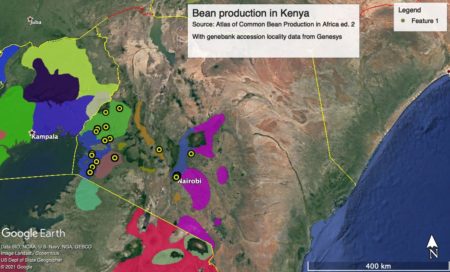- Grafting the Grape Virtual Lecture Series: Missouri Vines and Wines: Then and Now. Wait, that’s today!
- Mapping for Pastoralists, On-line Seminar. Phew, it’s next week.
- APPS Special Issue Call for Papers: “Meeting the Challenge of Exceptional Plant Conservation: Technologies and Approaches.” Relax, you have until June. Wait…
Nibbles: Emissions, Anthromes, S Asian farming origins, Old seeds, Chestnut, Canadian heirlooms, ABS newsletter
- Food contributes 1/3 of greenhouse gas emissions.
- How we got to the above.
- And a focus on how farming started in South Asia in particular.
- A long-term seed experiment carries on.
- Another chapter in the story of the comeback of the American chestnut?
- Want to help a heirloom make a comeback?
- There’s a newsletter on the law and policy behind all this stuff.
Brainfood: Post 2020 indicators double, Protected areas, Infraspecific variation, SeedExtractor, Processing, Regenerating spuds, Gut microbiota, Plant microbiome, Citrus greening, Rusts never sleep, Bee competition, Pollinator decline, Genomic selection, Pig diversity
- An analysis of genetic diversity actions, indicators and targets in 114 National Reports to the Convention on Biological Diversity. It is not well done, but the authors were surprised to see it done at all.
- Essential indicators for measuring site‐based conservation effectiveness in the post‐2020 global biodiversity framework. Remote sensing will save us. But see above.
- Pervasive cropland in protected areas highlight trade-offs between conservation and food security. Remote sensing (et al.) in action.
- Conserving intraspecific variation for nature’s contributions to people. Well, yeah. But can remote sensing help?
- SeedExtractor: An Open-Source GUI for Seed Image Analysis. Somebody mention intraspecific variation? Here’s a way to cope with seed variation.
- The processed food revolution in African food systems and the double burden of malnutrition. There’s bad processing, and good processing, even the bad processing has some upsides, but really we should try to have only good processing.
- Expression of internal reproductive barriers in a germplasm bank accession of the wild potato Solanum chacoense Bitter in three ex situ regeneration cycles. Ne < N.
- Effects of Iron and Zinc Biofortified Foods on Gut Microbiota In Vivo (Gallus gallus): A Systematic Review. Biofortified foods are good for gut health. In chickens.
- Experimental evidence of microbial inheritance in plants and transmission routes from seed to phyllosphere and root. Plants get their microbiome from the seeds whence they came, not just the environment.
- A stable antimicrobial peptide with dual functions of treating and preventing citrus Huanglongbing. From a wild relative, natch.
- Wheat rust epidemics damage Ethiopian wheat production: A decade of field disease surveillance reveals national-scale trends in past outbreaks. Boom-and-bust is alive and well.
- Honey bee hives decrease wild bee abundance, species richness, and fruit count on farms regardless of wildflower strips. And the good news just keeps on coming.
- Pollination strategies in the face of pollinator decline. The really good news is that plants may adapt to pollinator decline.
- Genomic Selection for Any Dairy Breeding Program via Optimized Investment in Phenotyping and Genotyping. You don’t need more money, you just need to reallocate some of the phenotyping money to genotyping, genotypers say.
- Runs of homozygosity provide a genome landscape picture of inbreeding and genetic history of European autochthonous and commercial pig breeds. Local breeds around Europe have similar genetic structures.
Nibbles: Bean atlas, Community seedbanks double, Canadian stamps
- New edition of the Atlas of Common Bean Production in Africa still doesn’t have localities of genebank accessions.
- Community seed banks have genebank accessions in Kenya and India.
- Canadian stamps have crabapple varieties that are probably genebank accessions somewhere.
Bean there, done that
Back in the day, together with co-authors Nigel Maxted and Edwin Chiwona, I used maps from the Atlas of Common Bean (Phaseolus vulgaris L.) Production in Africa 1 in a little thing called A Methodological Model for Ecogeographic Surveys of Crops. I don’t remember what software we used, and how difficult it was to do, as it was getting on for 25 years ago, but I suspect it was a bit of struggle mashing up the maps with genebank accession locality data.
Well, there’s a new edition of the atlas out, and, thanks to Genesys and Google Earth, it’s not quite so difficult (the colours represent ecologically distinct bean production areas).
Which is not to say it couldn’t be a bit easier. I mean, why not allow people to import their own data on the atlas’ nifty online interactive maps?
Oh, and BTW, only a tiny percentage of bean accessions from Kenya are geo-referenced, so that hasn’t changed much in 25 years.
